SONS OF DEWITT COLONY TEXAS
©1997-2018, Wallace L. McKeehan, All Rights Reserved
New Spain-Index
Nueva España
Nuevas Philipinas--Provincia de Tejas
Previous Page--First Republic
of Texas | Execution of Gov. Salcedo | First Constitution | Defeat at Medina/Arredondo's
Revenge
Coastal Independence Movements | Illegal Immigration Resumes | Adams-Onis Treaty
1819 | Last Filibuster-Dr. James Long | Legal,
Controlled Immigration-Moses Austin
For more biographies, Search
Handbook of Texas Online
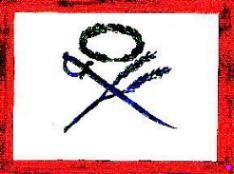 [Adventurer, buccaneer and
anti-Spanish filibuster Louis Michel Aury was thought to have flown this flag with white
field bordered by red with a green wreath above a blue sword and olive branch from his
heavily armed privateer vessels in the Gulf which were based in Galveston. Aury is said to
have also flown the Venezuelan tri-color with permission of the government to prey on
Spanish shipping. (Image from C. E.
Gilbert Jr. A Concise History of Early Texas: As told by its 30 historic flags, 1964)] [Adventurer, buccaneer and
anti-Spanish filibuster Louis Michel Aury was thought to have flown this flag with white
field bordered by red with a green wreath above a blue sword and olive branch from his
heavily armed privateer vessels in the Gulf which were based in Galveston. Aury is said to
have also flown the Venezuelan tri-color with permission of the government to prey on
Spanish shipping. (Image from C. E.
Gilbert Jr. A Concise History of Early Texas: As told by its 30 historic flags, 1964)]
Royal Forces Secure the Sabine River--Coastal
Independence Movements. For three years after the Battle of Medina and at the
expense of the population and property of Texas, Commandant of the Provincias Internas Joaquin
Arredonda under Viceroy Calleja were able to protect Spanish Texas against
significant attempts at penetration and filibustering, particularly by land from the east.
The extensive Texas coastline with its bays and Galveston Island was not as easy to
control. The area became a safe haven for adventurers and pirates preying on shipping in
the Gulf. In fall 1816, José Manuel Herrerra proclaimed a
government on Galveston Island as part of the Mexican Republic and appointed Louis
Michel Aury, a one-time associate of Simón Bolívar, as governor and naval
chief. According to some historians, Aury is described as a buccaneer, who was
commissioned by the Mexican revolutionists in the Hidalgo movement to secure Galveston
Island. After the deposition of the Hidalgo movement, Aury again turned to pirating and
preyed on vessels in the Gulf independent of flag. In 1816, Henry Perry,
an officer with Gutierrez and Toledo in the now scattered Republican Army of the North,
joined him on Galveston Island.
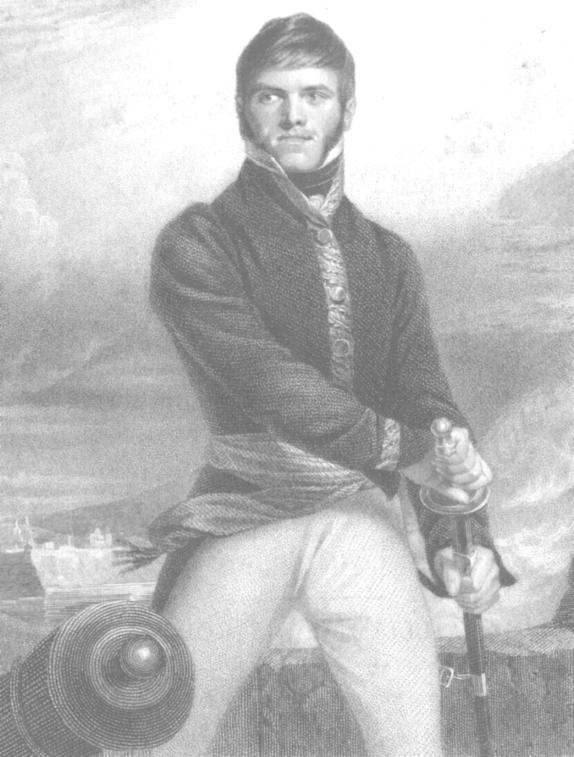 In
November 1816, the two adventurers were joined by Francisco Xavier Mina
(left) and his three ships from Spain where they targeted Spanish shipping in the Gulf.
Mina was an experienced Spanish patriot and revolutionary having fought against France in
the Spanish Peninsular War in 1810. He turned against restored King Ferdinand in 1815 and
made his way to America to continue his revolutionary activities against the crown, intent
upon invasion of Spanish Mexico. In April 1817, Mina and Aury landed at Nuevo Santander
and moved inland to Soto la Marina with a force of about 250, a large part of whom were
Anglo adventurers from east of the Sabine River. He hoped to eventually link up with
southern Mexican revolutionaries led by Guadalupe Victoria and others. He was met by
Commandant Joaquin Arredondo and routed. Mina escaped to join the Mexican rebels further
south, but in fall 1817 was captured and executed by firing squad. Capt. Perry and 50 men
moved to La Bahia along the coast from Galveston where he demanded surrender of the
Spanish garrison with intent to eventually link with Mina and Aury from the south. Texas
last Spanish governor, Antonio María Martínez from Bexar, met
Perry’s force near current Goliad on the plains of La Encinal del Perdido in what
some refer to as the Battle of the Perdido and routed
them. Seriously wounded Capt. Perry took his own life to avoid capture. Don Luis de Aury
returned to other adventures further south on the Central and South American coasts. He at
one time returned to Galveston Island to find it in possession of Jean Lafitte
who had set up a mini-kingdom with a fort and palace called Maison Rouge in a village
named Campeche. Lafitte at one time commanded over 20 vessels some of which were full
warships. [The portrait of Gen. Mina is from the frontispiece of William Robinson's
Memors of the Mexican Revolution, 1821. The caption of the illustration:
General Xavier Mina. From the Original Picture. Painted a few weeks before he left
England. In the possession of Tho. Broadwood, Esq.] In
November 1816, the two adventurers were joined by Francisco Xavier Mina
(left) and his three ships from Spain where they targeted Spanish shipping in the Gulf.
Mina was an experienced Spanish patriot and revolutionary having fought against France in
the Spanish Peninsular War in 1810. He turned against restored King Ferdinand in 1815 and
made his way to America to continue his revolutionary activities against the crown, intent
upon invasion of Spanish Mexico. In April 1817, Mina and Aury landed at Nuevo Santander
and moved inland to Soto la Marina with a force of about 250, a large part of whom were
Anglo adventurers from east of the Sabine River. He hoped to eventually link up with
southern Mexican revolutionaries led by Guadalupe Victoria and others. He was met by
Commandant Joaquin Arredondo and routed. Mina escaped to join the Mexican rebels further
south, but in fall 1817 was captured and executed by firing squad. Capt. Perry and 50 men
moved to La Bahia along the coast from Galveston where he demanded surrender of the
Spanish garrison with intent to eventually link with Mina and Aury from the south. Texas
last Spanish governor, Antonio María Martínez from Bexar, met
Perry’s force near current Goliad on the plains of La Encinal del Perdido in what
some refer to as the Battle of the Perdido and routed
them. Seriously wounded Capt. Perry took his own life to avoid capture. Don Luis de Aury
returned to other adventures further south on the Central and South American coasts. He at
one time returned to Galveston Island to find it in possession of Jean Lafitte
who had set up a mini-kingdom with a fort and palace called Maison Rouge in a village
named Campeche. Lafitte at one time commanded over 20 vessels some of which were full
warships. [The portrait of Gen. Mina is from the frontispiece of William Robinson's
Memors of the Mexican Revolution, 1821. The caption of the illustration:
General Xavier Mina. From the Original Picture. Painted a few weeks before he left
England. In the possession of Tho. Broadwood, Esq.]
 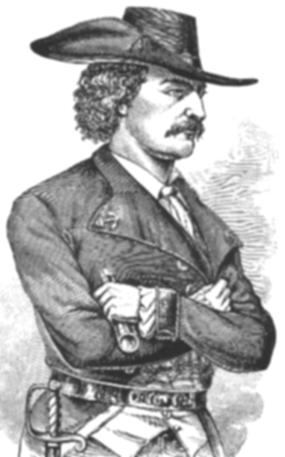 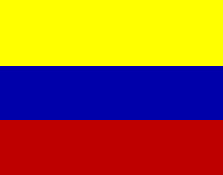
JEAN LAFITTE maintained control of Galveston
Island in the years 1818-1821. Lafitte was one of the most daring and colorful filibusters
of his time. He flew a solid, blood red flag from his masts and from time to time flew the
Venezuelan yellow, blue and red tri-color shown above. It is thought that he displayed, as
did Aury, the Venezuelan colors with permission of the government whose aim was to disrupt
Spanish shipping in the Gulf and Caribbean.
Illegal Immigration Resumes
from the East--French Exiles at Champ D'Asile.
Concurrent with the Mina-Perry expeditions from Galveston Island were increasing numbers
of settlers moving illegally across the Sabine River who clustered near Pecan Point south
of the Red River. Aided by Jean Lafitte in 1818, a group of about 400 French ex-patriates,
Tombigbee refugees, French nationals fleeing slave uprisings in the French West Indies,
some Spaniards, Mexicans, Poles and Anglo-Americans under a General Charles
François Antoine Lallemand arrived on Galveston Island with mixed, but
apparently primary motives of establishing a colony and new home. Joseph Bonaparte, an
exile in America, backed the group with his vision of liberation of New Spain French style
which would then help free his brother Napoleon from prison in St. Helena. The Tombigbee
episode was an attempt by a group of French exiles from Philadelphia, PA called the French
Agricultural and Manufacturing Society or Society of the Cultivation of the Vine and Olive
to establish a colony on the Tombigbee River in the Mississippi River Territory (now
Alabama). Upon suggestion by Spanish envoy to the USA, Luis de Onís, Lallemand attempted
to obtain permission to establish a colony in New Spanish Texas from the Viceroy, but he
was refused permission to land anywhere in New Spain. Under Gen. Antoine
Rigaud, the group moved illegally up the Trinity River to a place they named
Champ d’Asile (near current Liberty, LibertyCo, TX)
where they built a fort and began to plant crops including olive trees and grape vines.
Lallemand issued a manifesto of their intent to remain and
exercise their God-given right to establish homes in the area despite orders from royal
forces to leave. Threatened by Spanish forces from San Antonio and Indian attacks, the
idealists returned to Galveston Island where they experienced a major hurricane that
further decimated their meager resources. Some of the idealists returned to New Orleans,
some to Nacogdoches and others joined the "mini-kingdom" of Jean Lafitte.
Sabine River--Eastern
Border of New Spain by Adams-Onís Treaty of 1819. Amid
momentous independence movements on the European continent, the despotic reign of King
Ferdinand VII (1814-1833) and military-enforced constitutionalism (1820-1823), Spanish
rule in America and Texas was coming rapidly to a close. In 1819 the outright seizure of
both Florida and Texas by the USA was a serious concern. Spain had not undisputedly
controlled the area northeast of the Rio Grande River to the Arroyo Hondo and Calcasieu
Rivers by treaty since the Louisiana Territory was briefly returned to France in 1800. The
border remained a point of dispute and negotiation linked to the question of Spanish
Florida between Spanish minister to the USA, Don Luis de Onís de Gonzales, and American
Secretary of State John Quincy Adams, during the administration of President James Monroe.
The negotiations were aided in no small part by the international and internal problems of
Spain, which extended to New Spain. Proposals from the US side in the extreme was that the
border of the Louisiana Purchase was the Rio Grande River, then compromise proposals of
the Colorado River and then the east fork of the Trinity River. In 1819, Spain ceded
Florida to the USA for 5 million dollars and clear establishment of the border of New
Spain and the USA as the Sabine River north to the Red River, west to the 100th meridian
and north to the Arkansas River, following the Arkansas River and about midway between
current state of Colorado to the 42 parallel then west to the Pacific Ocean.
Last Filibuster into Spanish
Texas--Dr. Colonel James Long
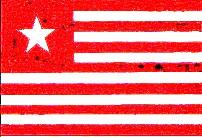 [This flag was displayed by the Long Expedition
and is considered by some to be the flag of the second Texas Republic (first was that set
up by the Republican Army of the North in
1812). It was the first movement for Texas independence that used the red and white
stripes of the newly founded Confederation of American States and was the first to display
a single Lone Star Image from C. E. Gilbert Jr. A Concise History of Early Texas: As told
by its 30 historic flags, 1964]. [This flag was displayed by the Long Expedition
and is considered by some to be the flag of the second Texas Republic (first was that set
up by the Republican Army of the North in
1812). It was the first movement for Texas independence that used the red and white
stripes of the newly founded Confederation of American States and was the first to display
a single Lone Star Image from C. E. Gilbert Jr. A Concise History of Early Texas: As told
by its 30 historic flags, 1964].
Dissatisfaction over the "concession" of Texas
to Spain precipitated the last major filibustering expedition to attempt to establish a
Republic within Spanish Texas. With financial backing from the uncle of his wife, Gen.
James Wilkinson, Col. Dr. James Long of Natchez, a former U.S.
Army surgeon in Carroll's Brigade in the War of 1812 under Gen. Andrew Jackson, raised
arms and followers with the objective to establish a Republic of Texas by connecting with
insurgents in Mexico which could be used as a base of solidifying independence in the
whole of Mexico. Long, an idealist experienced with the futility of war and violence for
greedy ends, was a man of some means and staked his entire fortune on the venture. Soon
after the war he met and married Miss Jane Wilkinson with whom he retired to his
plantation at Natchez. Through presumably Wilkinson associations he became very familiar
with the earlier experience and fate of Phillip
Nolan and directly with individuals having an active familiarity with
Texas. The group is thought to have been encouraged by General Andrew Jackson and others
in high echelons of the USA government, although official policy of the United States was
neutrality in regard to Spain. A force of near 300 occupied Nacogdoches, then troops were
spread with outposts from there to the coast and a government was established on 23 Jun
1819 with Long as President and Commander of the Army.
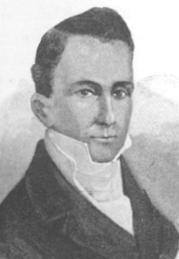 Among his "Supreme
Council" of advisors were Stephen Barker, Horatio Bigelow,
John G. Burnet, Hamlin Cook, J. Child, Peter Samuel Davenport
(photo left), Pedro Procello, John Sibley (photo below from
Lindenwood College), W.W. Walker, and Bernardo
Guti�rrez, former commander of the Republican Army of the North. In
addition to Long, Vicente Tarin,
former Commandant of the Second Flying Company of Alamo de Parras and anti-Spanish
resistance leader in Texas, was a signatory to Dr. Long's Declaration
of Independence where he is identified as "Secretary." Among his "Supreme
Council" of advisors were Stephen Barker, Horatio Bigelow,
John G. Burnet, Hamlin Cook, J. Child, Peter Samuel Davenport
(photo left), Pedro Procello, John Sibley (photo below from
Lindenwood College), W.W. Walker, and Bernardo
Guti�rrez, former commander of the Republican Army of the North. In
addition to Long, Vicente Tarin,
former Commandant of the Second Flying Company of Alamo de Parras and anti-Spanish
resistance leader in Texas, was a signatory to Dr. Long's Declaration
of Independence where he is identified as "Secretary."
Dr. John Sibley (1757-1837) was U.S. Indian agent for
the Orleans territory between 1805 to 1814. He is credited with maintaining
US-Indian relationships friendly to the United States from the Sabine River to Matagorda
Bay. Consequently, he was an object of intense observation by Spanish authorities.
His correspondence with Thomas Jefferson and the US government departments as well as to
US newspapers were rich with information on Texas in the period and is credited with
shaping US government policy. He operated from his long time home in Natchitoches
and participated with Long Expedition in Texas.
Horatio Bigelow was a newspaper man who edited the
Nacogdoches Texas Republican in 1819, was captured with James Long and other
members in 1821. He later returned to Nacogdoches, where he worked with the
Nacogdoches Mexican Advocate.
Peter Samuel Davenport (b. 1764) was a partner in the
trading cartel, The House of Barr and Davenport, which held a monopoly on trade with Texas
Indians sanctioned by the Spanish government. Davenport was the primary agent at one time,
operating from the Old Stone Fort in Nacogdoches.
A wealthy man, he was the major quartermaster and supplier of the Gutiérrez-Magee
expedition and became a captain participating in battle. A fugitive living in
relative luxury in Louisiana, he became quartermaster of the Long Expedition, eventually
returned to his villa Grand Ecore where he died in 1824.
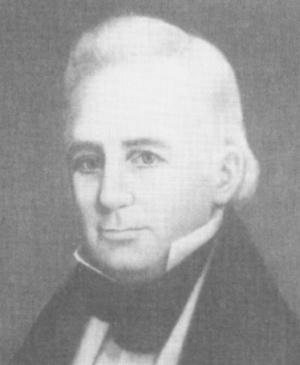 Liberal land laws, trading houses,
customs rules and a newspaper edited by Bigelow was established. After capture of
Nacogdoches, Long sent emissaries Johnson and Smith to attempt to enlist the support of
Jean and Pierre Lafitte and establish Galveston Island as a port of entry for the new
Republic of Texas. Lafitte responded and Long then outlined his invasion plan to Lafitte
with a message carried by associate Capt. James Gaines. The immediate response by Lafitte
was not encouraging. While preparing to meet Lafitte personally, Long learned that Royal
forces under Col. Ignacio Perez from San Antonio were marching toward
Nacogdoches. Long sent his family east across the Sabine and tried to avoid confrontation
with the Spanish forces. The camp under Capt. Johnson on the Brazos River was surprised
and 22 of Long's men captured by Perez. David Long, Col. James Long's brother, was killed
during the attack. Perez proceeded to Nacogdoches and in stepwise fashion destroyed
outposts established by the Long group on the Brazos and Trinity Rivers with surviviors
from each outpost fleeing to the next. At Capt. Smith's camp at the Coushatta Indian
village on the Trinity River, the remnants dispersed east across the Sabine River and some
down the Trinity to Bolivar Point where Col. Long and others met the few survivors. Perez
proceeded to destroy all traces of settlement that he could find whether Long related or
not and according to his report "I burned 30 habitations....They left large crops
of corn, potatoes, pumpkins, and various other vegetables, gangs of hogs, and flocks of
fowls....I left nothing which might possibly serve in [the] future." Liberal land laws, trading houses,
customs rules and a newspaper edited by Bigelow was established. After capture of
Nacogdoches, Long sent emissaries Johnson and Smith to attempt to enlist the support of
Jean and Pierre Lafitte and establish Galveston Island as a port of entry for the new
Republic of Texas. Lafitte responded and Long then outlined his invasion plan to Lafitte
with a message carried by associate Capt. James Gaines. The immediate response by Lafitte
was not encouraging. While preparing to meet Lafitte personally, Long learned that Royal
forces under Col. Ignacio Perez from San Antonio were marching toward
Nacogdoches. Long sent his family east across the Sabine and tried to avoid confrontation
with the Spanish forces. The camp under Capt. Johnson on the Brazos River was surprised
and 22 of Long's men captured by Perez. David Long, Col. James Long's brother, was killed
during the attack. Perez proceeded to Nacogdoches and in stepwise fashion destroyed
outposts established by the Long group on the Brazos and Trinity Rivers with surviviors
from each outpost fleeing to the next. At Capt. Smith's camp at the Coushatta Indian
village on the Trinity River, the remnants dispersed east across the Sabine River and some
down the Trinity to Bolivar Point where Col. Long and others met the few survivors. Perez
proceeded to destroy all traces of settlement that he could find whether Long related or
not and according to his report "I burned 30 habitations....They left large crops
of corn, potatoes, pumpkins, and various other vegetables, gangs of hogs, and flocks of
fowls....I left nothing which might possibly serve in [the] future."
Undaunted, Long returned to New Orleans to enlist more
help and support. He enlisted resigned American army General Eleazar W. Ripley of New
Orleans to help guide a renewed movement. Ripley was invited by Long's Supreme Council of
the Republic of Texas to become President and ex-officio Commander in Chief of the armies
and navies. Ripley outlined a detailed policy which included plans for stimulating trade,
culture, religion, education and manufacturing and agriculture. Slavery would be forbidden
in the new Republic. Ripley drew up plans for roads, bridges, canals and clearing land for
farms. There or in the meantime, Long was introduced to José Félix Trespalacios,
Ben Milam, John Austin and William
H. Christy, who were preparing an expedition to aid Republicans further
south in Mexico. Apparently, Ripley never came to Texas, although a son died in the Goliad
Massacre in 1836.
The group along with Mrs. Long and a servant sailed with
four vessels for Bolivar Point on the Bolivar Peninsula opposite Galveston Island. The
group is said to have actually seen Lafitte ships sailing out of the harbor for the last
time as they evacuated the coastal islands. The plan was for Trespalacios, Milam and
Christy to sail to Tampico and join Republicans there, then move up the coast to link with
Long's forces at La Bahia. According to author Stuart Foote in Texas and Texans,
Long in 1820 declared José Félix Trespalacios (then exiled in Cuba) President and
Bernardo Gutierrez (once commander and President of the Republic of the North) as
Vice-President. Leaving Mrs. Long and a small party on Bolivar, Long and a force of 52
sailed to Matagorda Bay, landed at the mouth of the Colorado River 15 miles above the
mouth at Mesquite Landing in the fall of 1821 and captured La Bahia and during that time
learned that Mexico had declared independence from Spain under Emperor Iturbide. At La
Bahia, superior royal forces under Col. Perez from San Antonio used deception that they or
a part of their force were sympathizers with the Republican forces of Mexico and captured
him and his men. After being marched to San Antonio as prisoners, they were transferred to
Laredo and then Monterrey and then escorted to Mexico City after signing of the Treaty of
Cordova and as Iturbide assumed control of the government of Mexico.
There Long and associates were honored by some as
patriots and met Trespalacios, Milam and Christy. Long's counsel and advice was listened
to until the appointment of Trespalacios as governor of Texas whereupon the interaction
between Long and the new governor cooled considerably. Long died in Mexico City where he
was shot and killed by a Mexican soldier under mysterious circumstances. He is said to
have been shot by a soldier in a small squad while removing his passport from a pocket.
Some accounts assume an accident. Author Stuart Henry Foote in his Texas and Texans,
1841, who claimed to have in hand Long’s personal notebooks, say that Long was in
Mexico City by invitation of the Iturbide regime as a champion of Mexican liberty. He came
under the suspicion of the Iturbide people and was assassinated on secret orders. Other
accounts theorize that his death was directed by associates of Trespalacios with whose
political advancement Long was a competitor and threat. Rumors suggested that Long was
also a candidate for the appointment by Emperor Iturbide for whom Gen. Wilkinson became a
close associate and advisor. After the death of Long, Milam, Austin, Christy and other
Long sympathizers left Mexico City for Monterrey and vowed to avenge his death. They
plotted to intercept Trespalacios on his way to Texas to assume his office, but were
betrayed by companions Wilson and Miller who alerted Trespalacios near Saltillo. All three
were arrested and escorted back to Mexico City via Saltillo, San Luis Potisi and
Queretaro. In Mexico, they were imprisoned for ten months along with some other members of
the Long Expedition.
In May 1822, President Monroe of the USA recognized the
independent Republic of Mexico. Monroe's ambassador to Chili, Poinsett of SC, passing
through Mexico was able to secure the release of the imprisoned Anglos in Dec 1822 and
they were transported on the US warship John Adams via Havana to Norfolk, VA. Poinsett was
appointed American ambassador to the Republic of Mexico where he presented his credentials
to first President Guadalupe Victoria in May 1825.
Participants in
Long's Force at Goliad
Commander James Long
Major Burns (England)
Captain John Austin
Captain Johnson
Captain Williams (Kentucky)
Lt. Chase (Massachusetts)
Lt. Egan ( New York, died at La Bahia)
Lt. Robertson (Tennessee)
Lt. Elliot (England)
Lt. Rosenberg (Germany)
and Toby (Massachusetts)
Sergeant Robertson (Scotland, a traitor)
Dr. Allen (Ireland, ex-surgeon in the British navy)
Aid-de-Camp E. Stanley Williams (Connecticut & Virginia)
Privates
Black (Louisiana), Bliker (Russia, traitor), Captain Browne (Sweden,
training for naval officer), George Early (Pennsylvania), Hamstein (German, traitor), John
McHenry (Ireland), Frank Kellar (Massachusetts), Ebenezer Lathrop (Massachusetts, killed
at La Bahia by accident), Lincoln (Massachusetts), McDonald (Maryland), Henry Nall
(England, Smith, Big and Little Patrick (Ireland father and son, blacksmiths and
traitors), Patton (died at La Bahia), Smith (jeweler), White (Old Blanco, killed at
Mesquite Landing), James Wilson (Tennessee, a traitor), John Wyatt (Pennsylvania), ten
more individuals.
(Traitors either joined or informed on their
colleagues to Spanish royalists for favors and/or clemency at La Bahia or Trespalacios and
associates at Monterrey)
(Participants compiled from History of
Texas by John Henry Brown, 1893. Brown footnotes that he obtained the Long
Expedition story first hand from his neighbor at Indianola, Captain John McHenry in 1853.
Brown first wrote what McHenry told him for his review and published it in De Bow's
New Orleans Review, 1853) |
A document in Spanish from the Nacogdoches Archives
lists the names, rank (or occupation), country of origin and religion of those captured at
La Bahia. The transcription of names (Nombres), occupation or rank (Empleos),
country (Patria) below are as transcribed without editing. The original document
also listed the prisoner's religion (catholic or protestant).
Lista delos Yndividuos
Aprehendidos en la Plaza de la Bahia q. se rindieron a discrecion despues de veinte y
quatro horas de fuego a las 11 del dia 9 de Octubre de 1821. y se remiten presos a
la comandancia Gral. con el Alf’z D’n Joaquin Saenz.
| Nombres |
Empleos |
Patria |
| Xayme Long |
General |
Americano |
| Simon Bourne |
Mayor |
Yngles |
| Guillermo Johnson |
Capitan |
Sueco |
| Juan Austin |
Capitan |
Americano |
| Carlos Drennen |
Capitan |
Americano |
| Jose Alexandro Tschitscherin |
id |
Polaco |
| Alexandro Williams |
1’er Ten’te de M’a |
Americano |
| Cs. Williams |
id |
id |
| Juan W. Smith |
id |
id |
| Juan C. Smith |
id |
id |
| Nathaniel Tobey |
id |
id |
| Tomas Chase |
id |
id |
| George Midkiff |
id |
escoces |
| Carlos Ellioth |
id |
Yngles |
| Daniel Dubal |
id |
Americano |
| Samuel Allen |
Medico |
Yrlandes |
| Euardo Haustein |
soldado |
Prusiano |
| Jose Dirksen |
id |
id |
| Anatasio Varon de Rosenberg |
id |
id |
| Guillermo Miller |
id |
id |
| Agustin Blaccher |
id |
Annoveriano |
| Miguel Kellyy |
id |
Yrlandes |
| Carlos Evans |
Marinero |
Prusiano |
| Guillermo Thompson |
id |
escoces |
| Enrrique Wals |
id |
Yngles |
| Guillermo Willson |
soldado |
Americano |
| Juan Smith |
|
Yrlandes |
| Juan C. Keller |
Marinero |
Americano |
| Alen White |
|
id |
| Juan Keys |
|
id |
| Teeke F. Gebbes |
marinero |
olandes |
| Patricio Hurley |
soldado |
Yrlandes |
| Andres Anderson |
marinero |
ruso |
| Gasper Porton |
marinero |
Aleman |
| Juan Wieatt |
|
Americano |
| Black (Ysack) |
|
id |
| Guillermo Lincoln |
soldado |
id |
| David Slater |
|
Yrlandes |
| Guillermo Pegan |
soldado |
Americano |
| Juan McKendry |
|
Yrlandes |
| Juan Robinsons |
soldado |
escoses |
| Antonio Miller |
id |
id |
| Patricio McDermitt |
id |
Yrlandes |
| Guillermo Mcdonald |
id |
Americano |
| Juan Sands |
id |
Americano |
| Guillermo Patten |
id |
escoces |
| Gregorio Carley |
id |
Americano |
| Jose O. Mitchill |
|
id |
| Carolos F. Brown |
|
sueco |
| Pedro Moran |
presentado |
Frances |
| Juan Franco. Dorblet |
id |
id |
| Antonio Ortiz Alias Brincakhargtos |
|
espanol |
| Thorp Robertson |
Ten’te |
Americano |
|
Mrs.
Jane Long is the subject of many stories in her own right of how she
survived on Bolivar Peninsula alone with her loyal servant girl and a newborn daughter
(married James S. Sullivan) while Dr. Long was in the field. In Apr 1822, Randall and
James Jones arrived to inform her of her husband's death. She traveled to San Antonio and
Natchez, visited Long's assassination site in Mexico and returned to reside in San Felipe,
Brazoria and then to Richmond where she died 30 Dec 1880 at the age of 82. She is buried
in Richmond and her gravesite is marked with a monument.
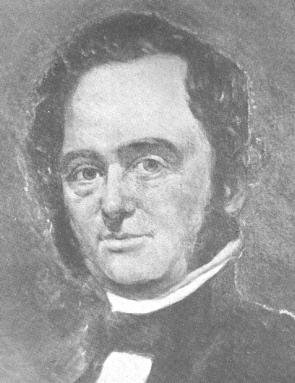 Legal and Controlled Immigration
Through Contract--Moses and Stephen F. Austin 1820-1821. Among those who began to
look toward Texas with the signing of the Adams-Onís Treaty as early as 1819 with some
knowledge of the liberal reforms going on in Spain and the Republican independence
movements within Mexico was former Spanish subject Moses Austin (photo)
of Missouri and his son Stephen F. Austin. Motivated by depression, personal financial
loss and increasingly difficult land policies in Virginia, Missouri and Arkansas, Moses
Austin arrived from Little Rock, AR with his Spanish passport of 1797 in San Antonio de
Bexar on 23 Dec 1820 with his black servant Richmond. Jacob Kirkham, who was searching for
runaway slaves, and Jacob Forsythe of VA, also investigating opportunities in Texas
accompanied him. Austin apparently had met both men in Natchitoches. Royal authorities
extensively examined him and at first he was ordered to leave Bexar immediately by
governor Martinez. However, he met Baron de Bastrop on the streets of Bexar whom he had
known in Louisiana. Bastrop intervened with Gov. Martinez, Austin was given a second
interview and, after approval of the ayuntamiento, Martinez approved and sent the
application to Commandante of the Provincias Joaquin Arredondo. Moses Austin declared he
was a 55-year-old subject of the King of Spain as shown by his passport of 1797, a
Catholic and that he carried no goods to be traded, only articles and supplies for his own
use on the trip. He stated that he was moved by the reinstatement of the liberal
constitution of Spain and desired to request permission, along with 300 other families, to
settle in the empire in fulfillment of his King’s desire at the time of the Louisiana
Purchase to allow his subjects freedom of movement between provinces. Legal and Controlled Immigration
Through Contract--Moses and Stephen F. Austin 1820-1821. Among those who began to
look toward Texas with the signing of the Adams-Onís Treaty as early as 1819 with some
knowledge of the liberal reforms going on in Spain and the Republican independence
movements within Mexico was former Spanish subject Moses Austin (photo)
of Missouri and his son Stephen F. Austin. Motivated by depression, personal financial
loss and increasingly difficult land policies in Virginia, Missouri and Arkansas, Moses
Austin arrived from Little Rock, AR with his Spanish passport of 1797 in San Antonio de
Bexar on 23 Dec 1820 with his black servant Richmond. Jacob Kirkham, who was searching for
runaway slaves, and Jacob Forsythe of VA, also investigating opportunities in Texas
accompanied him. Austin apparently had met both men in Natchitoches. Royal authorities
extensively examined him and at first he was ordered to leave Bexar immediately by
governor Martinez. However, he met Baron de Bastrop on the streets of Bexar whom he had
known in Louisiana. Bastrop intervened with Gov. Martinez, Austin was given a second
interview and, after approval of the ayuntamiento, Martinez approved and sent the
application to Commandante of the Provincias Joaquin Arredondo. Moses Austin declared he
was a 55-year-old subject of the King of Spain as shown by his passport of 1797, a
Catholic and that he carried no goods to be traded, only articles and supplies for his own
use on the trip. He stated that he was moved by the reinstatement of the liberal
constitution of Spain and desired to request permission, along with 300 other families, to
settle in the empire in fulfillment of his King’s desire at the time of the Louisiana
Purchase to allow his subjects freedom of movement between provinces.
[The Moses Austin Photo: According to
contemporaries Moses Austin was of short stature, corpulent, had beautiful teeth and a
charming smile. In the 1890's an elderly woman wrote Austin's grandson Guy M. Bryan
that she had a portrait of Moses Austin, commissioned by her husband, a steamboat captain
who hauled lead for Austin. The Bryan and Perry families declined to purchase
it. In 1904 Texas historian James T. Shields sold the portrait here to the Missouri
Historical Society, but he could not prove its provenance. The authenticity of the
portrait was and is controversial, even within the Austin family of the period. The
Missouri Historical Society withdrew the portrait from public display as Moses
Austin. In addition to the man who initiated colonization contracts from the United
States of the North in Texas, the father of the "Father of Texas," Austin is
also credited with being a founder of the lead industry in North America (information from
Gracy, Moses Austin: His Life 1987)]
Examination of
Moses Austin in Spanish Bexar 23 Dec 1820
At the City of San Fernando de Bexar, the 23d day of December, A D 1820 the
Governor of the Province of Texas, Colonel Don Antonio Martinez, in order to obtain
detailed information about the condition of affairs and movements on the frontier of the
United States, and the assembly of men in Galveston Island, summoned to appear at this
office the foreigner Moses Austin, who arrived to-day in this city, with two other
persons. Said Moses Austin being present was required through the Baron de Bastrop who had
promised well and truly to discharge the duty of Interpreter, to make true answers to such
questions as might be propounded to him, answered as follows.
Questioned as to his name, native country and
residence---Answered: That he is a native of the State of Connecticut, actually a resident
of Missouri, is a catholic, a merchant and dealer in lead ore.
Asked:---Whence he came, who accompanied him, and what is his object in entering this
Province? Answered: That he came from Missouri through Nachitotches, that he had been
accompanied by a negro boy belonging to him, and two other Americans; that he came to this
Province for the purpose of applying to the Government for authorization to settle himself
in it with his family, inasmuch as he had already been a subject of the Government of
Spain, as is proved by a passport, which he presented, signed by Don Carlos Martinez de
Irujo, Minister Plenipotentiary of His Majesty, signed at Philadelphia, the 13th July,
1797; and that it is his intention to provide for his subsistance by raising sugar and
Cotton.
Asked: what observations he made on his way from Missouri; if he knows anything about the
movements of the banditti on the frontier of the United States, if he has seen, or heard,
anything of the state of affairs in Galveston Island, and to state whatever incident may
have called his attention.---Answered: That he has observed nothing on his way from
Missouri; that be had only heard it said at Natchitoches that Long has been abandoned by
his men, 20 or 30 men only still remaining with him; that Lafitte has abandoned Galveston
Island, after having been attacked by an American frigate, and that the President of the
Congress had promised a reward of 500 Dollars for the apprehension of Long [Lafitte] That
Lafitte repaired to South America, but that, on his departure from Galveston, be captured
an American ship, and put to death all her crew, except two men who made good their
escape; and finally, that he has read in the American newspapers a treaty made by Don Luis
de Onis, Spanish Minister, with the American Congress, which treaty was already signed by
the King and approved by the Sovereign Congress of the Cortes
Asked; How, having obtained in 1797, a passport from the Spanish Minister, he has not
applied sooner for the Settlement he intends to make in this Province?---Answered---that,
since the year above mentioned, he went to reside at Saint Louis (Missouri) which
territory belonged, then to Spain; he had there lead mines, the produce of which he
exported to Havana, until the year 1800 [sic], when the American Government having
prohibited the working of mines by private enterprise, he lost all the benefit of his
labor; but now, in view of the new system of Government adopted by Spain he resolved upon
aplying for authorization to settle in this Province
Asked; If he, or his associates have with them any merchandize, to declare the same in
which case it should be sequestered and returned to them previous to their leaving this
territory, or otherwise, it should be seized upon as unlawful?---Answered, that all the
property he has with him, is an escopet, a pistol, two horses, some clothing for his
personal use, and the necessary amount of money for his traveling expences; that, those
who accompany him are not under his control, and joined him at about six leagues from
Natchitoches; Still, he is satisfied that they have no goods of illicit trade.
Asked: If he has any further statements to make; Answered in the negative, He, further,
ratified the foregoing answers, and declared himself to be 53 years of age; Whereupon, be
signed these presents, with me and assisting witnesses---Moses Austin---Antonio
Martinez---Baron de Bastrop---Francisco Montes---Ylario de la Garza
Moses Austin's
Application for Colonization [December 26, 1820
Señor Govor--Xefe Politico Dn Moses Austin, natural de La Prova de
Conecticut en los Estados Unidos de America y residente en La del Misuri con todo respecto
ante V S representa y dice, Que siendo vasallo de S M C quando La Prova de La Luisiana se
enageno a La Nacion Francesa, y de esta despues a Los Estados Unidos, como acreditan los
documentos credenciales qe a V S ha presentado, se vio el qe expone precisado a permanecer
a ella, sin intentar su emigracioir por no separarse de sus intereses, y propriedades, qe
unidos al amor de su familia lo detubieron; pero qe al saver el establecimiento de la
Constitucion politica de la Monarquia Española y qe por ella no se priva la trasladacion
de familias emigradas se ha resuelto a venir con objeto de Solicitar el correspondiente
permiso para domiciliarse en esta Provincia del mando de V S Y en el punto mas adequado
para la cultura de algodon trigo asucar maises etc., por cuya causa necesita en tal caso
elegir sitio aproposito segun sus conoscimientos Asi mismo trae encargo de tres cientas
familias qe con el mismo objeto estan deseosas de ver cumplida la intencion de Su M el rey
de España permitiendo al tiempo de transferir la referida Provincla qe todos los vasallos
qe voluntariamente, quisieren pudiesen pasar a establecerse a cualquiera parte de sus
dominios: como asi lo intentaron infinitas familias por entonces y repetidas veces, entre
ellas el qe reprela [representa] sin haverse podido conseguir por impidimiento de los
Xefes de estas Provas. En concepto de qe las indicadas familias qe solicitan por conducto
del qe habla su translacion, se comprometen a traer credenciales y testimonios
sertificantes De Su porte y conducta: qe todos ó la mayor parte son Personas de
proporciones y el qe caresce de ellas es hombre de industria Y qe se objeto estan deseosas
de ver cumplida la intencion de Su M el rey en defensa del govierno Español
ó contra Indios ó adventureros ó otra clase de enemigos qe intentan hostilisar accudiendo al
llamado y obedeciendo las Leyes y estatutos qe se les prevengan por todo lo qual A V S
respectuosamente Suplica se digne providenciarlo asi, si lo estimare justo y se halla con
facultades necesarias; y de no dar el correspondiente curso a donde convenga con el
informe qe halla pr conveniente cuya merced agradecera. Bexar
Experiencing extreme hardship and having to deal along
the way with the treachery of companion Kirkham, whose interest was illegal trade in
collaboration with local Spaniards, Austin returned to the USA and worked feverishly to
put his affairs in order and prepare for fulfillment of his proposal even before it was
approved. In mid-May 1821, he received word that Arredondo had approved his application on 17
Jan 1821. By the 10 of June, Moses Austin was stricken dead with pneumonia that many
attribute to his return trip and feverish preparations for return to Texas. His dying
request was that son Stephen F. Austin continue his vision and mission. On 18 Jun, son
Stephen F. Austin arrived in Natchitoches with a party of about ten and met emissaries of
Texas Gov. Martinez. Included in the group were Josef Erasmo Seguin, J.M. Verramendi and
others who were probably on personal trading missions in Louisiana in addition to
representing the governor. The Bexareños escorted Austin overland to San Antonio via
McGuffins Station between Natchitoches and the Sabine River and Camp Ripley on the Sabine
and Nacogdoches. In San Antonio, Austin was received cordially by former Gov. Martinez of
Spanish Texas and now Gov. Martinez of Texas, Republic of Mexico, on 12 or 13 Aug 1821
where the details of establishment of his plan were worked out with Bastrop and Seguin.
Peaceful Transition into the Republic of Mexico
under Governor Antonio María Martinez. On the morning of 19 Jul 1821, Gov.
Martinez officially replaced the Spanish Cross of Burgundy banner with the Mexican
tricolor on the civil plaza in San Antonio de Bexar, four months after Iturbide had
proclaimed the independence of Mexico under the Plan of Iguala and one month before Gen.
Juan O’Donoju, representing Spain, ratified the Treaty of Cordova on 24 Aug in Mexico
City. The transition was hardly noticed by residents of the area, but perceptive and
visionary residents of San Antonio along with Gov. Martinez were prepared to move quickly
to proceed with development and recovery of Texas from Spanish rule.
Despite renewed definition of the borders of Spanish
Texas in 1819 and de novo transfer of Texas to Mexico in 1821 by the Treaty of Cordova,
security and stability of the territory meant little without solid and productive
land-owning citizens comprising an economy in an atmosphere of security. Texas was
decimated during the death throes of the royal government and its successful attempts to
repel illegal immigration, filibustering and independence movements. In no small measure,
some of the destruction was also wrought by those attempting to separate Texas and Mexico
from Spain which often compromised the idealism behind their efforts. Gov. Martinez stated
in his own words "the king’s soldiers had drained the resources of the country,
and laid their hands on everything that could sustain human life…..the province
advanced at an amazing rate toward ruin and destruction." According to Gov. Martinez,
Texas had no more than 2516 souls in 1822 down from the 3103 recorded in the census of
1777. It had only two villages, San Antonio de Bexar and La Bahia. In 1821 Nacogdoches
which had up to 1000 inhabitants in 1812 prior to revolution and filibustering, was
essentially non-existent as a viable community. Jose Erasmos Seguin, during escort of
Stephen F. Austin to San Antonio, gathered what few hardy stragglers and squatters were in
the area in summer 1821 and, as Gov. Martinez’s representative, charged them to
organize as part of the imminent Republic of Mexico. Three of the four San Antonio
missions were unoccupied and near a state of ruin. There was a meager garrison at La Bahia
and a few families and the strongest in San Antonio that was pitifully equipped and
thievery and corruption for survival was a problem. Ironically, it was probably Gov.
Martinez’s willingness to turn his back on illegal trade by the letter of the law
that allowed the village to survive the period. Gov. Martinez and obviously both realistic
conservatives and liberal visionaries in the new Republic of Mexico became convinced that
legal and controlled immigration was the inevitable means to secure Texas as the
continuing buffer zone against USA expansion and to develop Texas economically, culturally
and politically.
Mexican
Independence Movements and Separation from Spain.
New Spain-Index
SONS OF DEWITT
COLONY TEXAS
©1997-2018, Wallace L. McKeehan, All Rights Reserved |





 [This flag was displayed by the Long Expedition
and is considered by some to be the flag of the second Texas Republic (first was that set
up by the
[This flag was displayed by the Long Expedition
and is considered by some to be the flag of the second Texas Republic (first was that set
up by the 
 Liberal land laws, trading houses,
customs rules and a newspaper edited by Bigelow was established. After capture of
Nacogdoches, Long sent emissaries Johnson and Smith to attempt to enlist the support of
Jean and Pierre Lafitte and establish Galveston Island as a port of entry for the new
Republic of Texas. Lafitte responded and Long then outlined his invasion plan to Lafitte
with a message carried by associate Capt. James Gaines. The immediate response by Lafitte
was not encouraging. While preparing to meet Lafitte personally, Long learned that Royal
forces under Col. Ignacio Perez from San Antonio were marching toward
Nacogdoches. Long sent his family east across the Sabine and tried to avoid confrontation
with the Spanish forces. The camp under Capt. Johnson on the Brazos River was surprised
and 22 of Long's men captured by Perez. David Long, Col. James Long's brother, was killed
during the attack. Perez proceeded to Nacogdoches and in stepwise fashion destroyed
outposts established by the Long group on the Brazos and Trinity Rivers with surviviors
from each outpost fleeing to the next. At Capt. Smith's camp at the Coushatta Indian
village on the Trinity River, the remnants dispersed east across the Sabine River and some
down the Trinity to Bolivar Point where Col. Long and others met the few survivors. Perez
proceeded to destroy all traces of settlement that he could find whether Long related or
not and according to his report "I burned 30 habitations....They left large crops
of corn, potatoes, pumpkins, and various other vegetables, gangs of hogs, and flocks of
fowls....I left nothing which might possibly serve in [the] future."
Liberal land laws, trading houses,
customs rules and a newspaper edited by Bigelow was established. After capture of
Nacogdoches, Long sent emissaries Johnson and Smith to attempt to enlist the support of
Jean and Pierre Lafitte and establish Galveston Island as a port of entry for the new
Republic of Texas. Lafitte responded and Long then outlined his invasion plan to Lafitte
with a message carried by associate Capt. James Gaines. The immediate response by Lafitte
was not encouraging. While preparing to meet Lafitte personally, Long learned that Royal
forces under Col. Ignacio Perez from San Antonio were marching toward
Nacogdoches. Long sent his family east across the Sabine and tried to avoid confrontation
with the Spanish forces. The camp under Capt. Johnson on the Brazos River was surprised
and 22 of Long's men captured by Perez. David Long, Col. James Long's brother, was killed
during the attack. Perez proceeded to Nacogdoches and in stepwise fashion destroyed
outposts established by the Long group on the Brazos and Trinity Rivers with surviviors
from each outpost fleeing to the next. At Capt. Smith's camp at the Coushatta Indian
village on the Trinity River, the remnants dispersed east across the Sabine River and some
down the Trinity to Bolivar Point where Col. Long and others met the few survivors. Perez
proceeded to destroy all traces of settlement that he could find whether Long related or
not and according to his report "I burned 30 habitations....They left large crops
of corn, potatoes, pumpkins, and various other vegetables, gangs of hogs, and flocks of
fowls....I left nothing which might possibly serve in [the] future." 